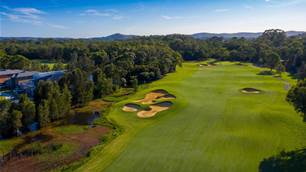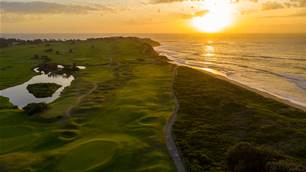There is something special about playing golf on the water’s edge, alongside beach sand and at the mercy of mother nature.
It is where the game’s origins lie in Scotland, on the grass covered sandy linksland that gave the natural undulations and interesting terrain to the likes of The Old Course at St Andrews, Turnberry and North Berwick.
In Australia, the use of land barely removed from the tides and waves has produced modern gems like the three courses on the Barnbougle property, as well as King Island’s Cape Wickham and Ocean Dunes.
Although the greater Sydney area is often derided for its quality of courses in competition with the famed Melbourne Sandbelt, one thing the harbour city does have in its favour is oceanside golf. And much of it is open for all to play.
A pocket of courses situated in Sydney’s eastern suburbs alongside the best layout in the city in NSW Golf Club encompasses Randwick, St Michael’s and The Coast Golf Clubs, all of which showcase the variety and quality of the city’s public golf played along the edge of the Pacific Ocean.
Where Randwick is short and quirky, St Michael’s continues to grow in stature and reputation. So too does The Coast, with its sometimes cliff traversing 18 holes and high-quality conditioning seeing the Little Bay course ranked 54th in Golf Australia magazine’s Top-100 Public Access Courses for 2023.

That ranking was an elevation by three places from two years prior, and for anyone who has paid a visit to the course, either for the first time or as a repeat guest, it is easy to understand how the course’s reputation continues to rise.
“Every time I visit The Coast I find some aspect of the course is better than it was before,” Top-100 Public Access Courses ranking, Julian Allen, said. “The presentation of the layout, particularly the putting surfaces, is one area that has improved markedly in recent years.”
The presentation has clearly been a focus for the thriving club of late, with former rugby league international and Coast member Luke Burgess telling this writer he doesn’t believe he has seen it in better “nick” in all his time there.
Greens roll true, and quickly downhill, while the fairways are an outstanding surface to play from and increasingly offer a variety of options when approaching greens more in keeping with the links-like feel of the setting.
That setting and the seemingly always present wind, combined with the conditioning, would almost be enough for a course like The Coast to achieve praise and visitors from far and wide. Yet it is the design of the holes lending plenty of weight to its standing among the best public tracks in the country.

A gentle opening of a par-4 and par-5 played side-by-side allows golfers to get into their stride before the first eye catching hole arrives in the form of the par-5 3rd.
A tee shot with internal out-of-bounds left courtesy of the practice fairway is simple enough before an infinity green (think infinity pool) appears in full view as you make your way along the 465-metre journey from the back tee. Perched above Little Bay Beach, the 3rd green is of a style that will become familiar during a round at The Coast, with a relatively small amount of mown grass in a circular shape. Two bunkers front the putting surface, but make no mistake the danger here is long with an overcooked wedge approach following a laid up second shot leaving golfers reaching into the bag for a new ball and swimmers ducking for cover below.
Long is no good at the par-5, however the next hole is best played with an extra club than the stated distance might require, that’s before you even factor in the wind of the day.
Measuring as much as 180 metres from the blue tees and 115 from the reds, the par-3 4th is without question the most memorable hole of the course, which was originally laid out by Jim Ferrier as a recreation area for staff and patients of the neighbouring Prince Henry Hospital and was updated by James Wilcher nearly a decade ago.

Although visually intimidating, the 4th is in fact playable for all golfers despite the direct line from tee to green covering a rocky inlet from the ocean from where golf balls do not return. Room to the right of the green leaves a good spot for the less daring, while the extra club from the tee can also remove the danger of the front left bunker.
“It doesn’t get any better than playing alongside the cliffs with million-dollar ocean views early and late in the round at The Coast,” Top-100 panellist Hamish Walker said. “The 180-metre 4th hole, demanding a tee shot over the rocky shoreline, is, in my opinion, one of the best par-3s in the country.”
Views of the ocean and the high likelihood of lost balls continue at the par-5 next as golfers start to prepare for the hardest hole on the course that is one of the furthest from the water’s edge.
At 403 metres, the par-4 7th is the hole most reworked by Wilcher, and even on the rare days of little to no wind at The Coast, it is no straight forward task.
It will be a lay-up from the tee for most players to avoid a small water hazard that cuts the fairway in half, and there isn’t much room right or left of the mown portion either. A long iron or rescue leaving plenty of yardage to a green that curves around the brush covered bank of a water hazard right, while a bunker short left makes things even more difficult.

A mix of difficult holes with others offering birdies is the theme of the back nine at The Coast, which takes its most dramatic turn at the par-4 14th.
From all but the most forward tee, a drive carrying a gorge, and more often than not played into the wind, is required to reach the right-to-left sloping fairway. The left side of the fairway, although courting the danger of a lost ball to the brush or water below, is the best place to approach the raised green which also slopes from right-to-left. Walking away with a par here is always a good result, a statement that is true for much of the remaining holes on the journey back to the clubhouse.
The 16th plays much shorter than its stated 322-metre scorecard distance due to the severity of the downhill slope of the fairway giving well struck tee shots plenty of run before an approach shot over water to a generously-sized green, offering a rare birdie chance in the closing stages.
Birdies are also in the offering at the last for longer players, who can take plenty of distance off the hole by going directly over the water short right of the green rather than following the dogleg right fairway around the hazard. But once again, a conservative line with par in mind is presented for shorter hitters and less daring players with a good score going.
That sort of risk-reward golf is something The Coast has amplified in recent times through the work completed by Wilcher, which has been greatly enhanced with updated irrigation work completed across the course in 2019.
Even if you aren’t blessed with the power to take on the bolder driving lines and longer par-3s, The Coast offers playability for all skill levels, while the enjoyment of playing the game across some of the best real estate in Sydney should help you forget any high numbers written on the scorecard.
FACT FILE
LOCATION: 1 Coast Hospital Rd, Little Bay, NSW, 2036
 CONTACT: (02) 9311 7422
CONTACT: (02) 9311 7422
WEBSITE: www.coastgolf.com.au
DESIGNERS: Jim Ferrier (late 1930s) and James Wilcher (2007-ongoing).
PLAYING SURFACES: Kikuyu and couch (fairways); Bentgrass/poa annua (greens).
COURSE SUPERINTENDENT: Jordan Roach.
PGA PROFESSIONALS: Jason King (Director of Golf), Sebastian Howell.
GREEN FEES: $70 (weekend peak); $60 (weekend off peak); $50 (weekend twilight); $55 (midweek peak); $50 (midweek off peak); $45 (midweek twilight).
ACCOLADES: Ranked No.54 in Golf Australia Magazine’s Top-100 Public Access Courses for 2023.
Related Articles

Review: Omaha Beach Golf Club

Top-100 Spotlight: Kooindah Waters Golf Club













